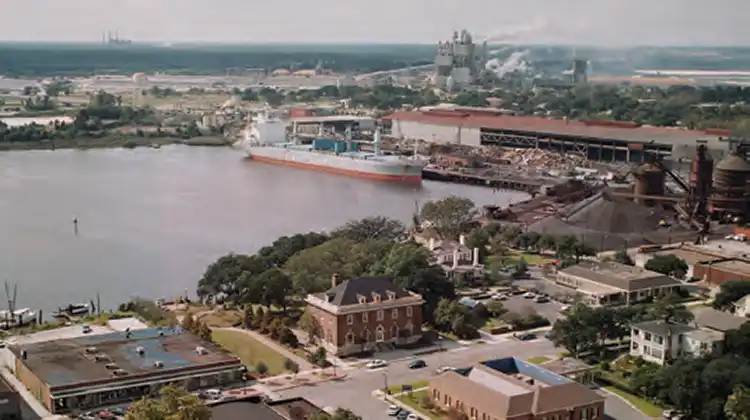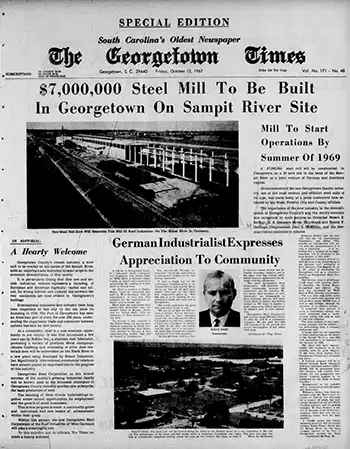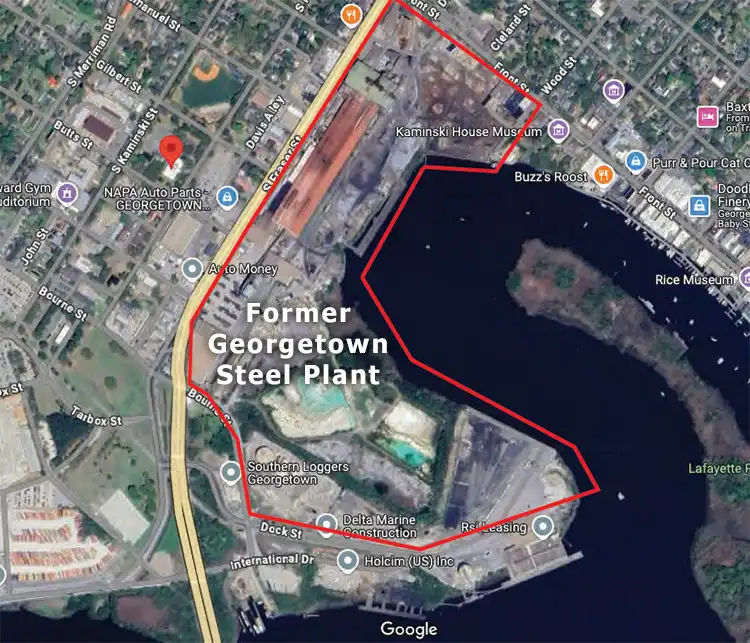
On Oct. 13, 1967, an article for a special edition of The Georgetown Times informed its readers that a German-based company called Korf Industries had chosen a 30-acre tract of land along the banks of the Sampit River as the site where it would develop the Georgetown Steel Corporation. The report stated that the $700,000 manufacturing facility would offer approximately 200 jobs initially.

For nearly 60 years the steel mill, which was bought and sold several times over the decades, has provided jobs that fueled the local economy. Yet the unsightly landmark bookended the entrance to the charming old port city, deterring some would-be tourists from exploring the darling shops, cafes and museums on historic Front Street.
That landscape is about to change. State House District 108 Rep. Lee Hewitt revealed that since the steel mill closed its doors in October 2024, he has been approached by a developer who is under contract for the purchase of the property. “Although plans haven’t yet been discussed and talks are in the early conceptual stage, I’m here to help improve how Georgetown could look,” he said. “I’m all for opening it up from the heavy, rusty industrial aesthetic and connecting the riverfront area with more shops, restaurants, waterfront parks, public access to water and workforce housing.”
Hewitt added, “The buyer understands that with the closures of the steel mill and the International Paper Mill, the people of Georgetown have been hit hard over the last year. He’s going to bring high-paying jobs back to the community so that folks can make a good living here with the clean-up, rebuilding and construction processes.”

Pointing to a similar project at Bethlehem Steel in Pennsylvania, which closed in 2003, John Olszewski, who now represents Maryland’s 2nd Congressional District in the U.S. House, said during an interview with PBS NewsHour in 2021, “While there may not be manufacturing jobs on site in the way that it was, people were excited to be working again. They were excited to have economic activity.”
In the same interview, Teaera Strum, chief operating officer of Strum Contracting Company, added that, “The revitalization allows (the project) to scale and grow and provide jobs for the community.”
Emmy-nominated producer and facilitator of the conversation, Karla Murthy emphasized, “Redevelopment is meeting a need in today’s economy.”
Aaron Tomarchio, senior executive at Tradepoint Atlantic, the real estate and development company that owns the former Bethlehem Steel facility, explained, “People want those older economy jobs back. And, you know, I don’t have the ability to bring them back. I have the ability to respond to the market and be able to provide the best opportunities for job creation in the market that we’re in.”
As was the case with Bethlehem Steel, pollution remediation at the site in Georgetown is going to take time, Hewitt said. “What was allowed when the Georgetown Steel Corporation was built in the 1960s is a whole lot different than the environmental requirements that have been put into place since. Everyone involved in this project admits that land is contaminated. However, the buyer’s background is in creating and executing mitigation plans to remove toxins from heavily-polluted sites in the Northeast and other areas. He said the soil analysis from the plant is nothing that he hasn’t seen before. He is aware that the leftover byproduct is going to take years to safely clean up.”
For those who have lost manufacturing jobs in Georgetown over the last year, the work will look different but the opportunities to come have significant potential. The redevelopment could have the most positive impact for job creation in a county that is still reeling from recent factory closures.
By Sarah Rose





Leave a Reply